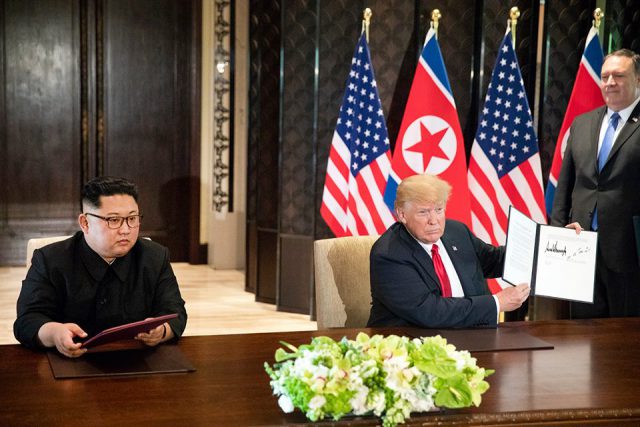
The summit in Singapore between US President Donald Trump and North Korea’s Kim Jong‑un finished with photo‑op fanfare and well-meaning handshakes and smiles. However, the Singapore declaration between Trump and Kim gives little confidence that a solution to North Korea’s nuclear threat is near.
International attention to this event suggested that many hoped it would finally signal that North Korea is ready to turn its nukes into ploughshares. But as I’ve indicated previously, it would be
foolish to hope that the crisis is over.
Far from it. We’re all waking up from the big party, and sober reality is settling in like a bad hangover: the Singapore summit represents—at best—no significant breakthrough. If anything, it suggests that Trump has been badly outmanoeuvred by Kim.
The optics of the summit were distressing. North Korea gained international recognition as a de facto nuclear-weapons state on equal standing with the United States. Kim met a sitting US president, who then praised him in front of the international media, conveniently ignoring the brutality of the man and his regime, including the torture and murder of Otto Warmbier. The US gave up the high moral ground in meeting with Kim.
Certainly the summit signals the start of an ongoing process of diplomacy between the US and North Korea to define and enact the ‘complete denuclearisation of the Korean peninsula’, which could last years. The North Koreans are masters at stringing out a diplomatic process to gain time and extract concessions while conceding little in return.
We’ve seen this Kabuki dance before. This time looks little different. Even some of the wording is the same. North Korea used the phrase ‘complete denuclearisation of the Korean peninsula’ in all of its previous negotiations with the West. It’s certainly not the preferred US approach to reach complete, verifiable and irreversible denuclearisation (CVID) quickly.
Worse, after the summit Trump unilaterally suspended US–South Korean military exercises, arguing that they’re ‘provocative’ to North Korea. Trump suggested that ending the exercises will save money, and seems to want to withdraw the 28,500 US military personnel stationed in South Korea. The real expense to be paid may be in decreased military readiness of US and South Korean forces to ‘fight tonight’ in the face of a continuing North Korean military threat, as well as a weakening of trust among US allies.
All for absolutely nothing in return from North Korea.
In adopting Pyongyang’s preferred language of ‘complete denuclearisation of the Korean peninsula’, Trump has opened a Pandora’s box of possible concessions by the US and South Korea over the coming months and years—before we see whether Pyongyang really will get rid of its nuclear weapons and its ballistic missiles. The language is risky for the US and its allies. It would certainly imply that the US should end its extended nuclear deterrence security guarantees to South Korea, and potentially to Japan as well. At a practical level, that would imply that the US must withdraw all dual-role, nuclear-capable forces from the Korean peninsula, including F‑16C/D fighters based at Osan and Kunsan, and potentially US dual-role combat aircraft based in Japan.
The North Koreans could also press for some sort of constraint on the deployment of nuclear-capable US naval forces, particularly after the 2018 US Nuclear Posture Review suggested
providing low-yield nuclear weapons to US Navy submarines, as well as nuclear-armed cruise missiles to submarines and possibly warships.
How such a measure would be enforced makes such a demand problematic at best. There’s nothing the North Koreans could do to stop the US from targeting North Korea with ICBMs or submarine-based SLBMs. Pyongyang could use that fact to justify holding onto its most capable nuclear forces rather than agreeing to quick CVID in any process.
Pyongyang also wants security assurances and the lifting of sanctions. Ending extended nuclear deterrence and withdrawing US military forces from on and around the Korean peninsula as part of any final peace agreement would form part of that requirement. That would see the US’s forward presence and influence weakened in Northeast Asia. The THAAD anti-ballistic missile defence system would have to be included, which would be welcomed in Beijing.
In this regard, the mechanics of denuclearisation are of secondary importance compared to the strategic message that it sends of a US retreating from essential security commitments to its allies. That raises the spectre of a vacuum that China—and potentially Russia—would fill, leaving Tokyo little choice but to consider its options for developing an independent nuclear deterrent.
This gets to the fundamental problem with the summit’s outcome: the declaration is vague. As a basis for proceeding with a diplomatic process that could provide more detail, it’s a start. But it cedes too many advantages to Pyongyang from the outset.
It sets a path for prolonged negotiations in a manner that North Korea prefers, allowing it to delay its own actions while extracting concessions from the US and its partners early and often. North Korea, with Chinese and Russian support, can exert maximum diplomatic pressure on the US and South Korea to sustain the process with the implicit or explicit threat of recommencing nuclear and missile testing if they don’t.
The US, having already moved away from talking about ‘maximum pressure’ and agreeing to North Korea’s preferred language, looks to be negotiating on Pyongyang’s terms and is less well placed to reverse course. The recognition given by Trump to Kim, including an invitation to visit the White House, has undercut US diplomatic options to restore ‘fire and fury’ and reinforces the North’s diplomatic advantage.
Kim Jong‑un must have been a happy man flying back to Pyongyang. He got all he wanted, and gave nothing of significance away. Donald Trump, sitting on Air Force One, probably thought he had achieved a great foreign policy success, and is probably waiting for that call from the Nobel Committee. It’s a call that shouldn’t come.
 Print This Post
Print This Post